A brief introduction to the treatment method of Grinding degree and Baking degree of Galapagos Fine Coffee beans

Minita), which is owned by the last three generations of the McAlpine family in England. In fact, this land can produce more than 450 tons of coffee a year. But Tarrazu Latin America coffee is grown without artificial fertilizers or insecticides, and its harvest and selection are done by hand, in order to avoid some damage to beans caused by air spray selection. Tarasu, Costa Rica is one of the major coffee producers in the world, with a light, pure flavor and pleasant aroma. Costa Rica, with its fertile volcanic soil and good drainage, is the first country in Central America to grow coffee and bananas for commercial value. Coffee and bananas are the country's main exports. Coffee was introduced into Costa Rica from Cuba in 1729 and today its coffee industry is one of the most well-organized industries in the world with a yield of 1700 kg per hectare. Costa Rica, with a population of only 3.5 million, has 400 million coffee trees, and coffee exports account for 25 per cent of the country's total exports. Costa Rica has also benefited from the Central American Society for Agricultural Research (Turrialba) in Tarasu.
Of the CentralAmerican Agricultural Research
Central mountain: after Colombia entered Ecuador, the Andes is divided into the eastern and western Cordillera mountains, with a plateau high in the north and low in the south, averaging between 2500 and 3000 meters above sea level. The Andes run through the middle of the border. The ridges crisscross, dividing the plateau into more than ten intermountain basins. The most important are the Quito basin and the Cuenca basin in the south. There are many volcanoes and frequent earthquakes in the territory. The famous Kotopaxi volcano, 5897 meters above sea level, is one of the highest active volcanoes in the world. Located in the middle of Ecuador, Mount Chimborazo, 6262 meters above sea level, is the highest peak of Ecuador, Mount Chimborazo in Ecuador. It is 6384.1 kilometers from the center of the earth to the top of the mountain. Mount Chimborazo, located in the West Cordillera in the Andes, has long been mistaken for the highest peak in the Andes. It is a dormant volcano with many craters and glaciers at the top of the mountain, which is more than 4694 meters. Port Guayaquil is the largest seaport in Ecuador. It faces the Pacific Ocean and backs against Mount Santa Ana. The nearby island of Pune serves as a natural barrier to protect the harbour from storms. There is a wharf in the south, which is more than 900 meters long. Ships from different parts of the world flying various flags are moored in the harbor. The port railway leads to the capital Quito, and highways connect Quito with other cities in the country. Bananas, cocoa, coffee, cotton and other products from all over the country are collected and distributed here. Guayaquil has also played an important role in the history of friendly exchanges between the peoples of China and Ecuador. As early as the 18th century, Chinese clothing, textiles and other goods were shipped to Ecuadorian cities through Guayaquil. In August 1978, the Chinese cargo ship Jialing River arrived here for the first time. Most of the import and export goods of the two countries are transhipped through Guayaquil.
When Thomas and the crew landed on the island, they were frantically looking for water and were so thirsty that they squeezed juice from the fat leaves of the cactus to drink. At last a source of water was found in a rocky gully. Thomas attributed it to the gift of God, because it was good Friday, and they had piously celebrated mass before they set out in search of water. But Thomas will never know that the island they landed on is the only island in the Galapagos archipelago that has plenty of fresh water, today's St. Cristobal Island (Saint Cristobal).
The Arabian Coffee Tree was first introduced to Ecuador in 1952 and its coffee is of good quality, especially the coffee harvested in early June. Ecuadorian coffee beans can be divided into two varieties: Galapagos and Gigante, both of which have the characteristics of large particles and heavy weight. Ecuadorian coffee can be divided into first class (No.1) and super excellent (Extra Superior) according to its quality. They are mainly exported to St. Cristobal, a Nordic country in Scandinavia, which is a larger island in the Galapagos archipelago. At 410m above sea level, there is a small lake called El.Junco. The lake forms several streams that flow along the rocks and volcanic rocks on the southern slope of the island, and mineral-rich fresh water nourishes the land of St. Cristobal. Keep the soil here moist and fertile forever. It provides the most rare conditions for the growth of coffee here.
In 1875, 340 years after Frey Thomas de Belanga discovered the island, a native named Corvus came to St. Cristobal, where he established the Hasunda Coffee Garden and planted about 100 hectares of Arabian bourbon coffee trees. Because the plantation is located between 140m-275m above sea level and the climate is equivalent to 915m-1830 m inland, the unique geographical conditions are very suitable for the growth of high acidity extra hard coffee beans (SHB), so this high-quality coffee has made its home here. Ecuador Class A Coffee, a well-known South American brand, has a large state-run seed value garden; 100% is produced in the natural vegetation zone of 1300-2000 Michael, popular in Europe and the United States, and tastes the exquisite world-class Arabica Arabica flavor at supermarket prices.
Other coffees worth mentioning are: Juan
Vinas,PR, H.Tournon, Windmill,SHB, Monte bello and Ssnta
Rosa). Fine coffee is generally grown in Geredia and the central canyon. Another striking coffee is Sarchi (one of the five towns representing Costa Rica's "Coffee Road"), which grows in the Boas volcano (Poas), 53 kilometers from San Jose
Volcano) on the hillside. Saatchi, founded in 1949, has a land area of 30770 hectares and grows sugar cane and coffee. The area is also famous for its handicrafts, attracting tourists from all over the world.
The country's coffee industry was originally owned by Costa Rica Coffee Industry Company (Instituto)
Controlled by del Caf é deCosta Rica, or ICAFE), and is now under the control of the official Coffee Committee (Oficinadel)
Caf é) take over.
ES Coffee is a clean organic coffee grown on the slopes of the Andes in Latin America. It is 100% pure coffee, and the quality of our coffee has been guaranteed and improved by working to improve the economic and working conditions of the plantation, while maintaining the small scale of the coffee plantation and the biodiversity in the hospital. In addition, it is one of the very important economic sources of coffee origin, because it is all dried and packaged locally, which ensures that it is a very unique kind of coffee in the world! At the same time, it ensures its unique taste.
Among the exported coffee, those products that are considered to be of substandard quality are colored with blue vegetable dyes and then transferred back to China for sale. Coffee consumed domestically (dyed blue or undyed) accounts for about 10% of total production, and local per capita coffee consumption is twice that of Italy or the United States. Tarasu is located in the capital, San.
In the south of Jos é, it is one of the most valued coffee growers in the country. Tarasu Latin America (La Minita)
Tarrazu) coffee is a famous local product, but the production quantity is limited, about 72600 kilograms per year. It is a piece called "La".
Important Notice :
前街咖啡 FrontStreet Coffee has moved to new addredd:
FrontStreet Coffee Address: 315,Donghua East Road,GuangZhou
Tel:020 38364473
- Prev

A brief introduction to the cultivation of pure aromatic Galapagos boutique coffee beans, geographical location, climate and altitude
Central mountain: after Colombia entered Ecuador, the Andes is divided into the eastern and western Cordillera mountains, with a plateau high in the north and low in the south, averaging between 2500 and 3000 meters above sea level. The Andes run through the middle of the border. The ridges crisscross, dividing the plateau into more than ten intermountain basins. The most important are the Quito basin and the Cuenca basin in the south. Internal fire
- Next

A brief introduction to the description of the flavor, taste and aroma characteristics of fine coffee beans
Year: 2012 Baker: Thirty Thirty Coffee Co. Link: http://www.coffeereview.com/review.cfm?ID=2928 Hachira N2 L12 Inspired by the Ninety Plus Aricha selections developed with S.A. Bagersh from 2006-2008, Hachira coffees are juicy and floral
Related
- Detailed explanation of Jadeite planting Land in Panamanian Jadeite Manor introduction to the grading system of Jadeite competitive bidding, Red bid, Green bid and Rose Summer
- Story of Coffee planting in Brenka region of Costa Rica Stonehenge Manor anaerobic heavy honey treatment of flavor mouth
- What's on the barrel of Blue Mountain Coffee beans?
- Can American coffee also pull flowers? How to use hot American style to pull out a good-looking pattern?
- Can you make a cold extract with coffee beans? What is the right proportion for cold-extracted coffee formula?
- Indonesian PWN Gold Mandrine Coffee Origin Features Flavor How to Chong? Mandolin coffee is American.
- A brief introduction to the flavor characteristics of Brazilian yellow bourbon coffee beans
- What is the effect of different water quality on the flavor of cold-extracted coffee? What kind of water is best for brewing coffee?
- Why do you think of Rose Summer whenever you mention Panamanian coffee?
- Introduction to the characteristics of authentic blue mountain coffee bean producing areas? What is the CIB Coffee Authority in Jamaica?

